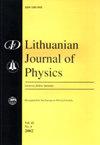On evaluation of image quality in nonparaxial single-pixel imaging
IF 0.6
4区 物理与天体物理
Q4 PHYSICS, MULTIDISCIPLINARY
引用次数: 0
Abstract
High numerical apertures lead to an appearance of distortions in a single-shot image, which make obtaining images troublesome if not impossible. These obstacles can be overcome in single-pixel imaging, where different strategies lead to inspection of objects with a good resolution, contrast and brightness. Recent advances in flat photonic elements have enabled the creation of compact nonparaxial imaging systems, which are especially promising in the THz range of wavelengths, bringing advances to such fields as communication, material inspection and spectroscopy. In this work, we dive into the problematics of single-pixel imaging: we introduce an object sample, which we use to investigate the resolution, contrast and brightness of the classical two-lens imaging setup. We evaluate the nonparaxial imaging of the sample and report that the conditions for the best contrast and the best brightness are decoupled in nonparaxial single pixel imaging. To overcome this hurdle, we use two integral image quality assessment techniques from computational imaging theory and estimate the quality of the image in a virtual numerical THz imaging scenario. The localized mean square error metric did not cause additional constraints to the quality of the image, whereas the global mean square error has restricted the range of possible imaging setups. Thus, the computational integral image quality assessment techniques back up the main claim of this study that in the single-pixel imaging the resolution is decoupled from the image brightness.非轴向单像素成像的图像质量评估
高数值孔径会导致单次拍摄的图像出现畸变,从而给获取图像带来麻烦,甚至是不可能。单像素成像技术可以克服这些障碍,通过不同的策略可以检测出具有良好分辨率、对比度和亮度的物体。扁平光子元件的最新进展使得紧凑型非同轴成像系统得以问世,尤其是在太赫兹波长范围内大有可为,为通信、材料检测和光谱学等领域带来了进步。在这项工作中,我们深入研究了单像素成像的问题:我们引入了一个物体样本,用来研究经典双透镜成像装置的分辨率、对比度和亮度。我们对样本的非轴向成像进行了评估,结果表明,在非轴向单像素成像中,最佳对比度和最佳亮度的条件是分离的。为了克服这一障碍,我们使用了计算成像理论中的两种积分图像质量评估技术,并估算了虚拟数值太赫兹成像场景中的图像质量。局部均方误差度量不会对图像质量造成额外限制,而全局均方误差则限制了可能的成像设置范围。因此,计算积分图像质量评估技术证明了本研究的主要观点,即在单像素成像中,分辨率与图像亮度是脱钩的。
本文章由计算机程序翻译,如有差异,请以英文原文为准。
求助全文
约1分钟内获得全文
求助全文
来源期刊

Lithuanian Journal of Physics
物理-物理:综合
CiteScore
0.90
自引率
16.70%
发文量
21
审稿时长
>12 weeks
期刊介绍:
The main aim of the Lithuanian Journal of Physics is to reflect the most recent advances in various fields of theoretical, experimental, and applied physics, including: mathematical and computational physics; subatomic physics; atoms and molecules; chemical physics; electrodynamics and wave processes; nonlinear and coherent optics; spectroscopy.
 求助内容:
求助内容: 应助结果提醒方式:
应助结果提醒方式:


